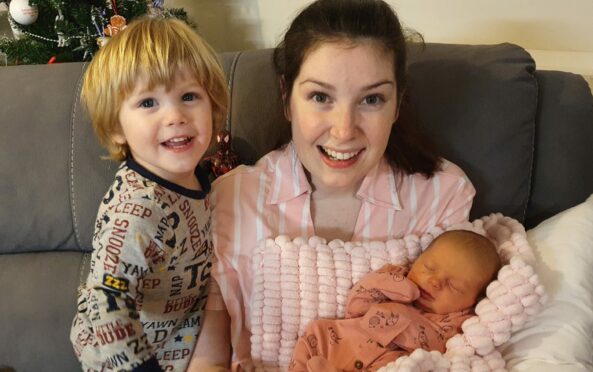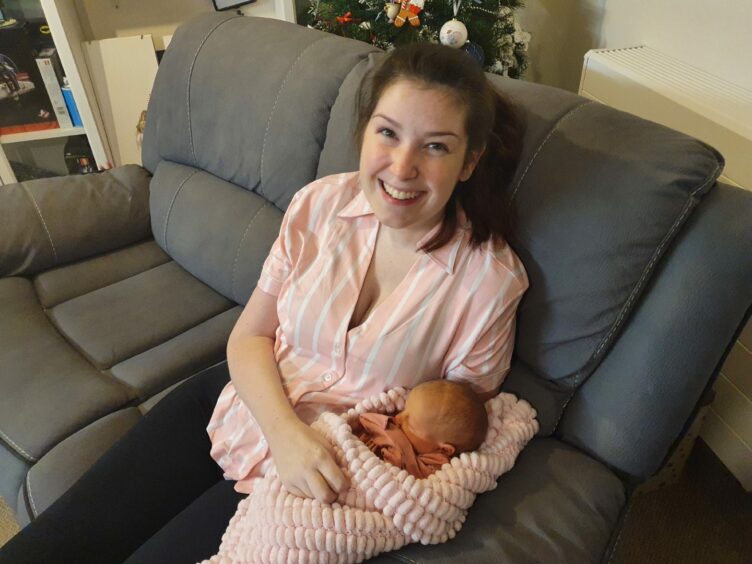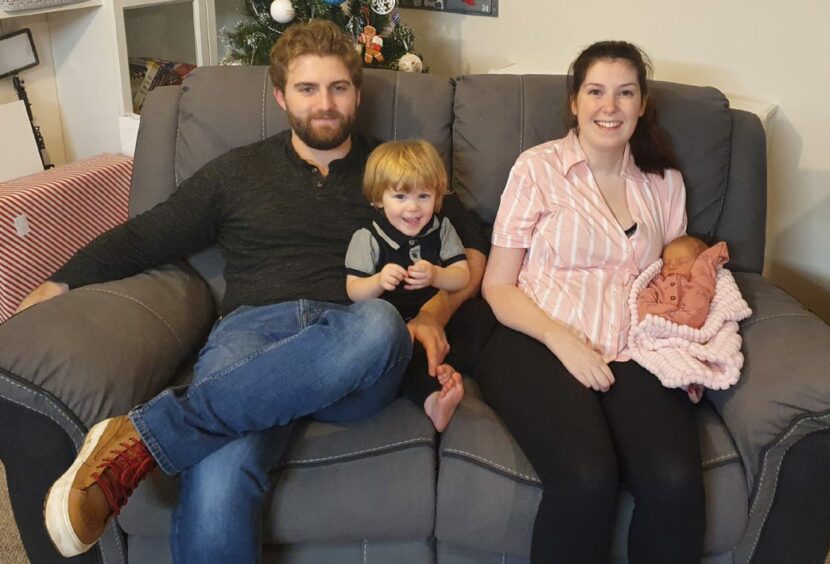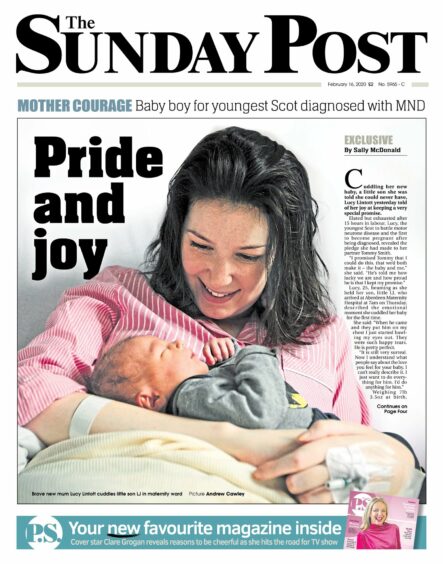
If the birth of her son felt like a miracle, Lucy Lintott – and her doctors – believe the arrival of his baby sister is every bit as wondrous.
The youngest Scot to battle motor neurone disease is celebrating the birth of a daughter in what medical experts believe may be a world first.
She was 19 when doctors told her she had the illness and a life expectancy of just 14 months. That was eight years ago. But determined to live her best possible life, the 27-year-old had a baby son in February 2020, to become one of only five MND patients to become mothers after diagnosis.
Now, we can reveal, Lintott and fiancé Tommy Smith, 26, have just welcomed a baby daughter into the world. Originally due on New Year’s Eve, she was born two weeks early at Aberdeen Maternity Hospital, weighing healthy 6lbs, 13-and one-quarter ounces. A week old, her parents are still deciding on a name but have meantime lovingly dubbed her AR – a wee sister for toddler LJ, who is two.
Speaking after their arrival back home in Elgin, Morayshire last week, Lintott told The Post: “I have wanted children for as long as I can remember. I feel like the luckiest woman in the world now I have both my babies. We couldn’t be more delighted.”
Smith, a second year apprentice plumber and heating engineer, added: “Having our son, and now our beautiful daughter is so special. Lintott and the baby came home from hospital on Tuesday, LJ is quite intrigued by his little sister. He points at her and says ‘baby’ and says that he loves her.” And with a laugh, he added: “But when we got up this morning and the baby was still here he seemed a little shocked.”
The team at Aberdeen Maternity Hospital decided to induce the birth after Lintott suffered a difficult pregnancy marred by sickness that led to dehydration and a brief spell at Dr Gray’s Hospital in Elgin.
She said: “I was in labour for 13 hours and was really shattered. When our daughter was finally born she gave a little cry and was placed on my chest, and then went straight to sleep. She had a really stressful birth. Every time I had a contraction, her heart rate dropped. They didn’t know why. It was a lot for her little body. We missed having an emergency Caesarean section by the skin or our teeth.”
Smith explained that Lintott was on a hormone drip to encourage contractions and the dilation of her cervix. But the drip had to be halted periodically to stop the contractions and allow the medical team to check on the baby’s status.
He said: “They said they would have to do a scratch test on the baby’s head, which involves taking a sample of blood to see how she was doing, just in case the monitors were not accurate. They told us that if the results were bad Lintott would have to have an emergency C-section. They were already prepping for that as they talked. But as they put one of Lintott’s legs up on a stirrup to check her and do the test she said she felt the baby move.”
Smith explained the baby had fallen into the correct birthing position, and with Lintott’s cervix now properly dilated, it was unlikely she would need surgery but the medical team went ahead with the scratch test just to be certain. “It took about five or 10 minutes before we had the result and we were worried sick,” he said. “The C-section would have been horrific for us because of the risks involved. It was quite an upsetting atmosphere. But the test result came back ok at 4.30pm. Lintott started pushing at 4.50pm and the baby was born at 5.07pm.”
Lintott said: “I was delighted when I finally had my arms around her. I was so relieved.” Her fiancé added: “Holding our little girl after Lucy’s first cuddle was amazing. I have wanted a daughter for as long as I can remember.”
Speaking to us last year, Lintott – dubbed the MND Warrior after she raised £200,000 towards finding a cure for the condition, despite knowing any breakthrough may not come in time to save her own life – said: “I always felt selfish because I wanted to be a mum. I felt like, am I being greedy because there are other people out there with terminal illnesses and it is not even an option for them.
“And I feel selfish, because at the moment this is a terminal illness and I may not be around as my baby boy gets older. I’d be leaving Tommy as a widower. But then I remember our son is already getting a better start to life as he has parents who love him and love each other, and he has four amazing grandparents.”
Pride and joy: Six years on, youngest Scot to be diagnosed with MND cuddles miracle baby
The mum – who relies on a wheelchair and with her children has to live apart from their dad in supported accommodation while they face a two-year wait for a specially adapted rental home – said of her new baby: “I wanted LJ to have a buddy. If I pass away he would always have a best friend, and I wanted to give Tommy a little girl. They would all be able to look after one another.”
The couple thought hard about the slight risk of the disease affecting their children but believe it is worth taking. There are two types of MND, familial and one-off or sporadic.
About one in 15 people with the disease will know of another close family member who also has it.
So far, the faulty genes that cause the illness have not triggered in any other member of the Lintott family. Studies of people with sporadic MND suggest that the overall risk for their children is only very slightly increased. The absolute lifetime risk of developing MND is roughly 0.3%, and a small increase in that figure still equates to very low risk.
Smith said the couple planned to try for a baby after LJ’s first birthday. He said: “We started trying at the beginning of March and Lucy was pregnant in the middle of April.”
They announced they were having a daughter to The Sunday Post in August. At the time Lintott revealed: “My obstetrician said that after LJ she didn’t think she’d see me back and when she discharged me, my case file showed I was one in five women in the world with MND to become pregnant. When I became pregnant with this baby and went back to her, she joked, ‘You just had to be No. 1 didn’t you?’”
But Smith this week told The Post his fiancée is shy about making medical history. He said: “Lucy hates admitting that. But when she had LJ the doctors made lots of medical notes, because the chance that someone with MND would have a baby is so rare. They documented as much as they could so that students could learn. Now Lucy has provided another batch of evidence towards that. It’s good considering that when Lucy first became pregnant there was little to no information or evidence of that kind to say how things would go. At least now, the medical profession has information from two recent births in someone with MND. It must surely help others. It might be special to someone else with MND one day.”
But Lintott said: “All I did was get pregnant. Women do it every day. I am not special. If you want something bad enough you will try to make it happen. But I’m definitely done now,” she smiled. “I have completed my family, without a doubt.”
Wonder drug could stop and even reverse awful disease
Researchers could soon be delivering fresh hope to MND sufferers.
The disease is a progressive, incurable and terminal condition affecting the brain and nerves but laboratory discoveries have buoyed scientists. MND causes nerve cells – neurones – controlling the muscles to degenerate and die. Muscles waste away affecting movement, speech and breathing. There is one approved medication for the disease but it only extends life by two to three months. Around 1,500 people in the UK are diagnosed with MND each year.
Earlier this year, scientists at the Euan MacDonald Centre for MND Research at Edinburgh University, proved axons – the long nerve fibres which connect and send electrical impulses from the nerve cells to the muscles – are shorter in cells affected by MND. They also discovered the movement of the mitochondria, the tiny energy cells which move up and down the axons, is impaired.
But they found that the damage to the nerve cells caused by MND can be repaired by boosting the energy levels in these mitochondria. Once this was done, the axon reverted back to normal length. The effect was achieved in the lab using motor neurons grown from stem cells collected from people with a genetic mutation known to cause MND. These lab-grown neurons were then exposed to a virus which supercharged a key molecule vital to the healthy functioning of mitochondria.
The research team believe it will be able to produce the same result in patients – not with a virus, but by re-purposing an existing drug.
Work is under way to identify drugs that can boost the mitochondria and repair the motor neurons, leading to clinical trials. Researchers said: “We believe that this technique of rescuing the axon through boosting energy will not only slow and stop but could reverse the degeneration, so it could potentially be very powerful.”

Enjoy the convenience of having The Sunday Post delivered as a digital ePaper straight to your smartphone, tablet or computer.
Subscribe for only £5.49 a month and enjoy all the benefits of the printed paper as a digital replica.
Subscribe

